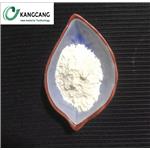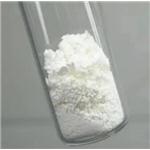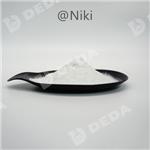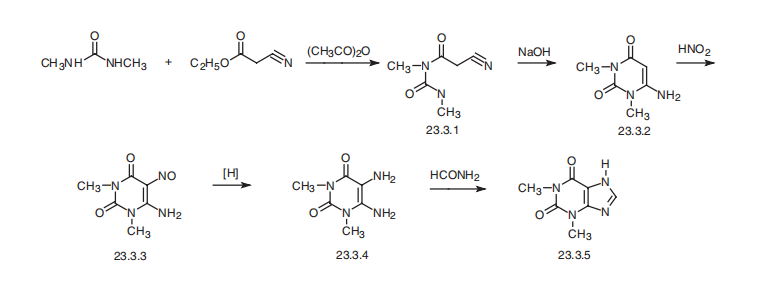- Theophylline
-

- $9.00 / 1gram
-
2024-04-24
- CAS:58-55-9
- Min. Order: 1gram
- Purity: min99%
- Supply Ability: 100 tons
- Theophylline
-

- $70.00 / 10kilograms
-
2024-04-24
- CAS:58-55-9
- Min. Order: 10kilograms
- Purity: 99%
- Supply Ability: 100tons
- Theophylline
-

- $10.00 / 1kg
-
2024-04-23
- CAS:58-55-9
- Min. Order: 1kg
- Purity: 99%
- Supply Ability: 100ton/ month
Related articles - Caffeine EP impurity A
- Caffeine EP Impurity A chemically known as theophylline has been utilized in the treatment of asthma and chronic obstructive p....
- Jul 26,2023
- The toxicology of theophylline
- Theophylline can reduce the tension of smooth muscle and dilate respiratory tract; It can promote the release of endogenous ep....
- Apr 13,2022
|
| | Theophylline Basic information |
| | Theophylline Chemical Properties |
| Melting point | 271-273 °C | | Boiling point | 312.97°C (rough estimate) | | density | 1.3640 (rough estimate) | | refractive index | 1.6700 (estimate) | | Fp | 11 °C | | storage temp. | 2-8°C | | solubility | 0.1 M HCl: soluble | | form | powder | | pka | 8.77(at 25℃) | | color | white | | Water Solubility | 8.3 g/L (20 ºC) | | Merck | 14,9285 | | BRN | 13463 | | BCS Class | 3,1 | | Stability: | Stable. Incompatible with strong oxidizing agents. | | InChIKey | ZFXYFBGIUFBOJW-UHFFFAOYSA-N | | LogP | -0.020 | | CAS DataBase Reference | 58-55-9(CAS DataBase Reference) | | IARC | 3 (Vol. 51) 1991 | | NIST Chemistry Reference | 1,3-Dimethylxanthine(58-55-9) | | EPA Substance Registry System | Theophylline (58-55-9) |
| | Theophylline Usage And Synthesis |
| Description | Theophylline is a methylxanthine that acts as a weak bronchodilator. It is useful for chronic therapy and is not helpful in acute exacerbations.
Theophylline is a methylxanthine alkaloid that is a competitive inhibitor of phosphodiesterase (PDE; Ki = 100 μM). It is also a non-selective antagonist of adenosine A receptors (Ki = 14 μM for A1 and A2). Theophylline induces relaxation of feline bronchiole smooth muscle precontracted with acetylcholine (EC40 = 117 μM; EC80 = 208 μM). Formulations containing theophylline have been used in the treatment of asthma and chronic obstructive pulmonary disease (COPD). | | Chemical Properties | white to light yellow crystal powder | | Physical properties | Appearance: white, crystalline powder, odorless, with a bitter taste. Solubility:
freely soluble in solutions of alkali hydroxides and in ammonia; sparingly soluble
in alcohol, in chloroform, and in ether; slightly soluble in water. Water solubility,
7.36?g/L (20?°C); density, 1.62?g/cm3
; melting point, 270–274?°C; boiling point,
390.1?°C (760? mmHg); flash point, 189.7?°C; vapor pressure, 2.72E-06? mmHg
(25?°C). | | History | Theophylline was firstly extracted from tea leaves and chemically identified by the
German biologist Albrecht Kossel. A cup of tea contains about 1?mg/mL theophylline. In 1895, a chemical synthesis of theophylline starting with 1,3-dimethyluric
acid was described by Emil Fischer and Lorenz Ach. Theophylline was synthesized by Wilhelm Traube in 1900. Aminophylline, a derivative of theophylline ethylenediamine, is widely used due to its greater aqueous solubility.
Theophylline was firstly used clinically as a diuretic in 1902. Twenty years later
it was firstly reported by D.I.?Macht and G.C.?Ting for asthma treatment in pig bronchial smooth muscle. The first successful clinical use of theophylline in bronchial
asthma was reported in 1922 by S.? Hirsch, who described that four patients
responded well to the rectal administration of a mixture of 66.7% theophylline and
33.3% theobromine. He also tested the combination of theophylline with theobromine on bovine bronchial smooth muscle strips and noted smooth muscle relaxation. Thus he concluded that dimethylxanthines act by producing relaxation of
bronchial smooth muscle. In 1937, two concurrent but independent clinical trials
reported that methylxanthines were efficacious in asthma. The Food and Drug
Administration approved the use of theophylline for asthma in the USA in 1940.
There are more than 300 derivatives of theophylline. The main derivatives
include aminophylline, dihydroxypropyl theophylline, and oxtriphylline.
2. Doxofylline: 7-(1,3-dioxalan-2-ylmethyl) theophylline. It has antitussive and
bronchodilator effects. In animal and human studies, it has shown similar
efficacy to theophylline but with fewer side effects. Related research has
showed that the effect of doxofylline on airway relaxation is 10–15 times that of
aminophylline.
3. Diprophylline: 7-(2,3-dihydroxypropyl)-1,3-dimethyl-3,7-dihydro-1H-purine-
2,6-dione. Diprophylline is the neutral preparation of theophylline. It causes less
of nausea and gastric irritation.
4. Oxtriphylline: choline theophyllinate; administered orally. Oxtriphylline is five
times more soluble than aminophylline.
| | Uses | theophylline is tonic and skin conditioning. Its cosmetic activity is not clearly or definitively established. It is most often found in anti-cellulite products. Theophylline is in the same family of bio chemicals as caffeine. It is naturally occurring in tea. | | Uses | Xanthine derivative with diuretic, cardiac stimulant and smooth muscle relaxant activities; isomeric with theobromine. Small amounts occur in tea. Bronchodilator. | | Definition | ChEBI: Theophylline is a dimethylxanthine having the two methyl groups located at positions 1 and 3. It is structurally similar to caffeine and is found in green and black tea. It has a role as a vasodilator agent, a bronchodilator agent, a muscle relaxant, an EC 3.1.4.* (phosphoric diester hydrolase) inhibitor, an anti-asthmatic drug, an anti-inflammatory agent, an immunomodulator, an adenosine receptor antagonist, a drug metabolite, a fungal metabolite and a human blood serum metabolite. | | Indications | Twenty years ago theophylline (Theo-Dur, Slo-bid,
Uniphyl, Theo-24) and its more soluble ethylenediamine
salt, aminophylline, were the bronchodilators of
choice in the United States. Although the β2-adrenoceptor
agonists now fill this primary role, theophylline
continues to have an important place in the therapy of
asthma because it appears to have antiinflammatory as
well as bronchodilator activity. | | General Description | Odorless white crystalline powder. Odorless. Bitter taste. | | Air & Water Reactions | Slightly soluble in water. | | Reactivity Profile | Theophylline neutralizes acids in exothermic reactions to form salts plus water. May be incompatible with isocyanates, halogenated organics, peroxides, phenols (acidic), epoxides, anhydrides, and acid halides. Flammable gaseous hydrogen may be generated in combination with strong reducing agents, such as hydrides. | | Hazard | Questionable carcinogen. | | Fire Hazard | Flash point data for Theophylline are not available, however Theophylline is probably combustible. | | Biological Activity | Bronchodilator, anti-inflammatory and immunomodulator. Antagonizes adenosine receptors and is a weak non-selective inhibitor of phosphodiesterases (PDEs). | | Biochem/physiol Actions | Phosphodiesterase inhibitor; diuretic; cardiac stimulant; muscle relaxant; asthma medication. | | Mechanism of action | In spite of a great deal of investigation, just how theophylline causes bronchodilation is not clearly understood. Inhibition of the enzyme PDE, which is responsible for the hydrolysis of cAMP and cyclic guanosine monophosphate (cGMP), generally is put forth as the mechanism of action; however, theophylline also is an adenosine antagonist and has been implicated in stimulation of the release of catecholamines. It has been clearly shown that theophylline does inhibit PDEs in vitro, and x-ray crystallographic studies have identified the binding residues that interact with the methylxanthines. Theophylline binds to a subpocket of the active site and appears to be sandwiched between a phenylalanine and a valine via hydrophobic bonds. Its binding affinity is reinforced by hydrogen�bonding between a tyrosine and N-7 and a glutamine and O-6 of the xanthine ring system. There are more than 11 families of PDEs, and studies have shown that theophylline binds in a similar manner to both the PDE4 and PDE5 family isoforms. | | Pharmacology | Theophylline can reduce the tension of smooth muscle and dilate respiratory tract; It can promote the release of endogenous epinephrine and norepinephrine and relax airway smooth muscle; Inhibit the release of calcium ions from the endoplasmic reticulum of smooth muscle, reduce the concentration of intracellular calcium ions and produce respiratory tract dilation. Theophylline has a strong relaxation effect on smooth muscle, but it is not as good as β Receptor agonists. On October 27, 2017, the list of carcinogens published by the international agency for research on cancer of the World Health Organization was preliminarily sorted out for reference. Theophylline was included in the list of Category 3 carcinogens. | | Pharmacology | Smooth muscle relaxation, central nervous system
(CNS) excitation, and cardiac stimulation are the principal
pharmacological effects observed in patients
treated with theophylline.The action of theophylline on
the respiratory system is easily seen in the asthmatic by
the resolution of obstruction and improvement in pulmonary
function. Other mechanisms that may contribute
to the action of theophylline in asthma include
antagonism of adenosine, inhibition of mediator release,
increased sympathetic activity, alteration in immune
cell function, and reduction in respiratory muscle
fatigue. Theophylline also may exert an antiinflammatory
effect through its ability to modulate inflammatory
mediator release and immune cell function.
Inhibition of cyclic nucleotide phosphodiesterases is
widely accepted as the predominant mechanism by
which theophylline produces bronchodilation. Phosphodiesterases
are enzymes that inactivate cAMP and
cyclic guanosine monophosphate (GMP), second messengers
that mediate bronchial smooth muscle relaxation. | | Clinical Use | The principal use of theophylline is in the management
of asthma. It is also used to treat the reversible component
of airway obstruction associated with chronic obstructive
pulmonary disease and to relieve dyspnea associated
with pulmonary edema that develops from
congestive heart failure. | | Side effects | Theophylline has a narrow therapeutic index and produces
side effects that can be severe, even life threatening.
Importantly, the plasma concentration of theophylline
cannot be predicted reliably from the dose. In
one study, the oral dosage of theophylline required to
produce therapeutic plasma levels (i.e., between 10 and
20 μg/mL) varied between 400 and 3,200 mg/day.
Heterogeneity among individuals in the rate at which
they metabolize theophylline appears to be the principal
factor responsible for the variability in plasma levels.
Such conditions as heart failure, liver disease, and severe
respiratory obstruction will slow the metabolism of
theophylline. | | Safety Profile | Human poison by
ingestion, parenteral, intravenous, and rectal
routes. Experimental poison by multiple
routes. An experimental teratogen. Human
systemic effects: coma, convulsions or effect
on seizure threshold, cyanosis, EKG
changes, fever and other metabolic effects,
heart arrhythmias, heart rate change,
hyperglycemia, metabolic acidosis, nausea or
vomiting, potassium-level changes,
respiratory stimulation, salivary gland
changes, somnolence, tremor. Experimental
reproductive effects. Human mutation data
reported. Used as a dturetic, cardtac
stimulant, smooth muscle relaxant, and to
treat asthma. When heated to
decomposition it emits toxic fumes of NOx. | | Synthesis | Theophylline, 1,3-dimethylxanthine (23.3.5), is present in small quantities
in tea leaves. It is synthesized synthetically by the Traube method, a general method suggested
for making purine bases. In the given example, reacting N,N-dimethylurea with
cyanoacetic ether in the presence of acetic anhydride gives cyanoacetylmethylurea (23.3.1),
which cyclizes into 6-amino-1,3-dimethyluracil (23.3.2). The resulting compound transforms
into 5-nitroso-6-amino-1,3-dimethyluracil (23.3.3) upon reaction with nitric acid.
Reduction of the nitroso group gives 5,6-diamino-1,3-dimethyluracil (23.3.4), the subsequent
reaction of which with formamide gives the desired theophylline (23.3.5). 
| | Drug interactions | Potentially hazardous interactions with other drugs
Antibacterials: increased concentration with azithromycin, clarithromycin, erythromycin, ciprofloxacin, norfloxacin and isoniazid; decreased plasma levels of erythromycin if erythromycin taken orally; increased risk of convulsions if given with quinolones; rifampicin accelerates metabolism of theophylline.
Antidepressants: concentration increased by fluvoxamine - avoid or halve theophylline dose and monitor levels; concentration reduced by St John’s wort - avoid.
Antiepileptics: metabolism increased by carbamazepine, phenobarbital and primidone; concentration of both drugs increased with fosphenytoin and phenytoin.
Antifungals: concentration increased by fluconazole and ketoconazole.
Antivirals: metabolism of theophylline increased by ritonavir; concentration possibly increased by aciclovir.
Calcium-channel blockers: concentration increased by diltiazem and verapamil and possibly other calcium-channel blockers.
Deferasirox: concentration of theophylline increased.
Febuxostat: use with caution.
Interferons: reduced metabolism of theophylline.
Tacrolimus: may increase tacrolimus levels.
Ulcer-healing drugs: metabolism inhibited by cimetidine; absorption possibly reduced by sucralfate. | | Environmental Fate | Theophylline is readily broken down in the environment.
It may undergo photolytic degradation in the air or when
exposed to light. In moist soil, or aqueous environments, it
undergoes rapid biodegradation. | | Metabolism | Chemically, theophylline is 1,3-dimethylxanthine and contains both an acidic and a basic nitrogen
(N-7 and N-9, respectively). Physiologically, it behaves as an acid (pKa = 8.6), and its poor
aqueous solubility can be enhanced by salt formation with organic bases. Theophylline is
metabolized by a combination of C-8 oxidation and N-demethylation to yield methyluric acid
metabolites. The major urinary metabolite is 1,3-dimethyl uric acid, which is the
product of the action of xanthine oxidase. Because none of the metabolites is uric acid itself, theophylline can be safely given to patients who suffer from gout. | | storage | -20°C | | Purification Methods | It crystallises from H2O as the monohydrate which becomes anhydrous above 100o. It is freely soluble in hot H2O, but its solubility at 15o is 0.44%. It complexes with heavy metals. It is a diuretic, vasodilator and a cardiac stimulant. [Lister Purines Part II, Fused Pyrimidines Brown Ed, Wiley-Interscience pp253-254 1971, ISBN 0-471-38205-1, Beilstein 26 H 455, 26 I 134, 26 II 263, 26 III/IV 2331.] | | Toxicity evaluation | In acute overdoses, theophylline often causes severe emesis (75% in acute vs 30% in chronic). The emesis is often difficult to control with antiemetics. It is thought that theophylline causes increased gastric acid secretion and smooth muscle relaxation. Theophylline causes a release of endogenous catecholamines, and therefore is a cardiac stimulant. There is a positive inotropic and dose-dependent chronotropic response. Tachydysrhythmias, especially supraventricular tachycardia, are common due to adenosine receptor antagonism. Ventricular tachydysrhythmias can occur as well in acute overdose; however, they are rare at therapeutic concentrations. Rapid administration of aminophylline has resulted in sudden cardiac death. Hypokalemia, hypercalcemia, and hyperglycemia may contribute to arrhythmias as well. In cases of chronic toxicity, dysrhythmias occur at lower serum concentrations (40–80 mg ml-1) compared to acute overdose. Theophylline will stimulate the CNS respiratory center causing increased respiratory rate and can lead to respiratory alkalosis. Theophylline will cause CNS stimulation and vasoconstriction, similar to caffeine, and may lead to headache, anxiety, agitation, insomnia, tremor, irritability, hallucinations, and seizures. Methylxanthines exhibit weak diuretic effects by increasing cardiac output and renal vasodilation. Theophylline has a narrow therapeutic index, with 12–25% of overdose patients developing serious or life-threatening symptoms including arrhythmias and seizure. Toxicity can develop at lower serum concentrations for those treated chronically or older patients. Age greater than 60 years and chronic use are risk factors for increased morbidity and mortality. | | Precautions | Theophylline should be used with caution in patientswith myocardial disease, liver disease, and acutemyocardial infarction. The half-life of theophylline isprolonged in patients with congestive heart failure.Because of its narrow margin of safety, extreme cautionis warranted when coadministering drugs, such as cimetidineor zileuton, that may interfere with the metabolismof theophylline. Indeed, coadministration of zileutonwith theophylline is contraindicated. It is alsoprudent to be careful when using theophylline in patientswith a history of seizures. | | References | Fischer., Ber., 30, 553 (1897)
Schwabe., Arch. Pharm., 245, 312 (1907)
Biltz, Strufe.,Annalen, 404, 137, 170(1914)
Yoshitomi., Chem. Abstr., 19,2303 (1925)
Mossini., Boll. chim. farm., 75, 557 (1936)
Deichmeister., Farm. Zhur., 13, 18 (1940)
Deichmeister., Chem. Zentr., 1, 1280 (1942)
Deniges., Bull. trav. soc. ph arm. Bordeaux, 79, 141 (1941)
Lesser., Drug & Cosmetic Ind., 66, 276,340 (1950) |
| | Theophylline Preparation Products And Raw materials |
| Raw materials | Ethyl cyanoacetate-->3,7-dihydro-1,3-dimethyl-1H-purine-2,6-dione, potassium salt-->Caffeine-->1,3,7-TRIMETHYLURIC ACID-->1,7-DIMETHYLXANTHINE-->Theobromine | | Preparation Products | 1,3-Dimethyluric acid-->8-Bromotheophylline-->Doxofylline-->1,3-Dimethyl-8-nitro-1H-purine-2,6(3H,9H)-dione ,97%-->Aminophylline-->CHOLINE THIEOPHYLLINATE-->ISOCAFFEINE-->teomorfolin-->1,3-Dimethyl-8-nitro-3,7-dihydro-1H-purine-2,6-dione |
|